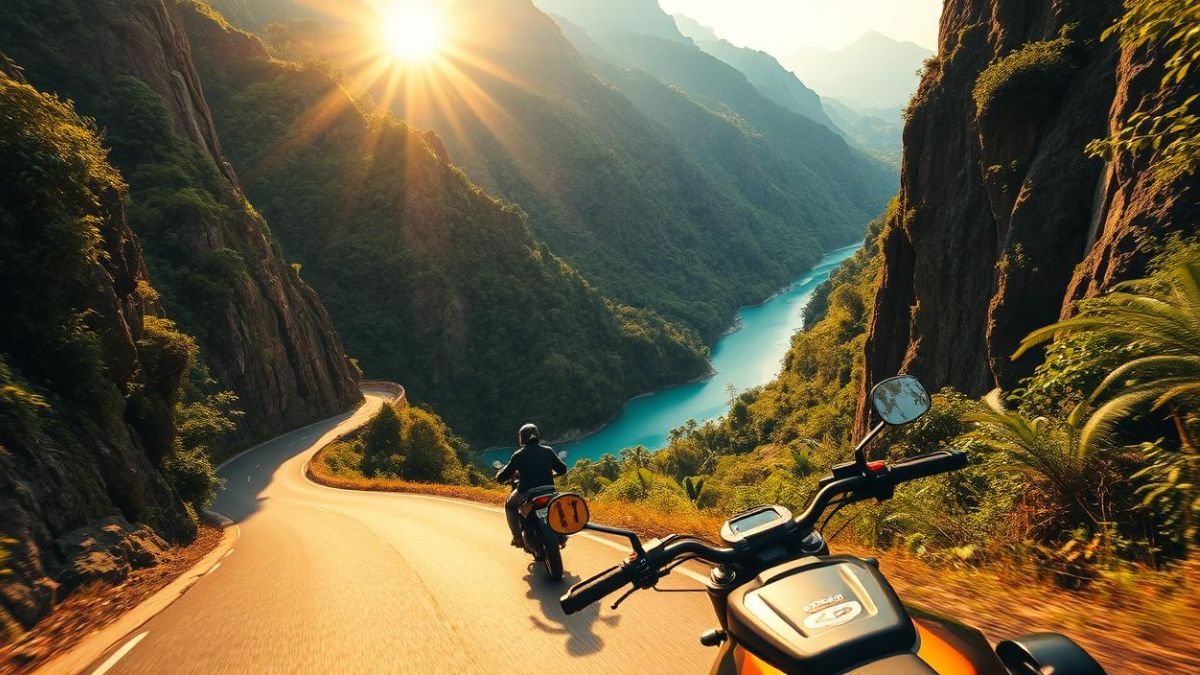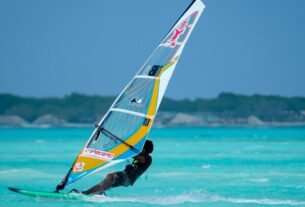Introduction
Ever wondered what it’s like to ride through lush jungles, coastal highways, and historic trails—all in one journey? A Motorcycle Trip Cross Country in Brazil offers some of the world’s most breathtaking landscapes for riders seeking the ultimate adventure.
With diverse terrains that range from the thick, verdant canopies of the Amazon rainforest, where the air is rich with the sounds of wildlife and the scent of exotic flora, to the stunning coastal highways that hug the Atlantic Ocean, revealing panoramic views of sun-drenched beaches and azure waters, it’s a dream destination for those who love the open road.
The historic trails wind through charming towns and cities, each with its own unique stories and cultural heritage, inviting riders to stop and explore. Whether navigating the twists and turns of a mountain pass or cruising along a tranquil country road, every mile in Brazil is filled with excitement and discovery, making it an unforgettable experience for motorcycle enthusiasts.
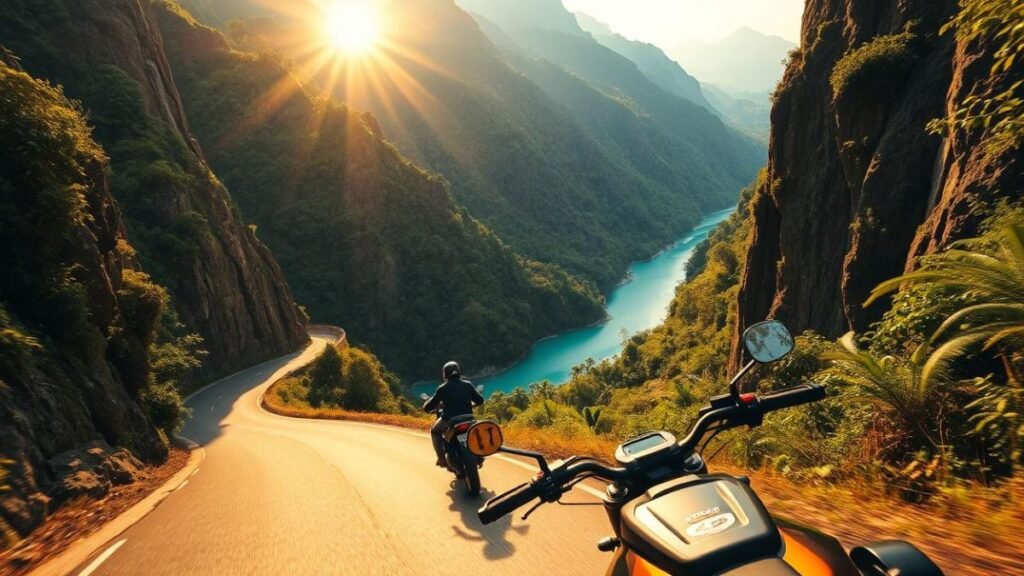
From the Amazon’s dense rainforests to sun-kissed beaches, this guide covers seven handpicked routes that blend challenge and beauty. Whether you crave winding mountain passes or serene countryside rides, Brazil delivers unforgettable experiences. Each trail is a gateway to rich history, local flavours, and jaw-dropping scenery.
Key Takeaways
- Brazil is a top-tier destination for long-distance motorcycle adventures.
- The routes feature jungles, coasts, and historic paths, offering a variety of experiences.
- Total mileage across all trails caters to both short and extended tours.
- Cultural immersion and terrain diversity are central themes.
- Logistical tips ensure smooth planning for riders.
Introduction: Why Brazil is a Motorcycle Touring Paradise
Few places on Earth blend biodiversity and culture as seamlessly as Brazil’s open roads. Spanning 8.5 million km²—nearly triple the size of the US lower 48 states—the country packs jungles, mountains, and coasts into one thrilling ride.
The sheer variety of landscapes is staggering, from the dense, vibrant rainforests teeming with wildlife to the rugged mountains that offer breathtaking views at every turn. Coastal regions provide a refreshing breeze and stunning ocean vistas, making every journey an unforgettable experience.
Every route tells a story, weaving through vibrant towns and untouched wilderness, where riders can immerse themselves in the local culture, taste regional cuisines, and meet the friendly locals who embody the spirit of Brazil.
From Rainforests to Coastlines: Brazil’s Diverse Terrain
Brazil’s six major biomes create a playground for riders. The Amazon’s lush canopy, the Cerrado’s savannas, and the Pantanal’s wetlands demand different skills. Coastal routes like BR-101 serve up ocean views, while the Serra do Rio do Rastro tests agility with hairpin turns.
| Feature | Brazil | US (Lower 48) |
|---|---|---|
| Total Area | 8.5 million km² | 3.1 million km² |
| Biomes | 6 distinct zones | 4 primary zones |
| UNESCO Sites | 23 cultural/natural | 12 natural |
Cultural Richness Along the Way
Days on the road reveal Brazil’s soul, an intricate tapestry woven from diverse cultures and histories. Colonial towns like Ouro Preto, with their stunning baroque architecture and cobblestone streets, invite exploration and reflect the country’s rich past.
Indigenous markets in Manaus, vibrant and bustling, trade handcrafted goods made by local artisans, offering a glimpse into the traditions that have endured through generations. Coastal fishing villages, where the rhythm of life revolves around the sea, serve fresh moqueca stew—a delicious and aromatic dish made with fish, coconut milk, and spices—fuel for the next leg of your journey through this captivating land.
Pro Tip: Local riders recommend using physical maps for remote areas, as cell service can be unreliable in the vast wilderness, leaving travellers without a connection. Paper never fails and provides a reliable backup. Pair routes with UNESCO stops, like the breathtaking Iguaçu Falls, to blend nature and history, ensuring that each ride is not just a journey through landscapes but also a deep dive into Brazil’s cultural heritage.
1. The Trans-Amazonian Highway: A Jungle Odyssey
Deep in Brazil’s heart lies a road less travelled, where adventure meets the wild. The BR-230, stretching 4,000km from Marabá to Lábrea, cuts through the Amazon’s untouched greenery. Sixty per cent of the route is unpaved, demanding skill and preparation for the ultimate ride.
Route Overview: BR-230’s Untamed Beauty
This highway is a mix of gravel, mud, and occasional pavement, making it a true test of endurance and skill for any rider. Expect river crossings that can vary in depth depending on the season, and sudden rain showers that turn paths slick and treacherous, transforming the ride into an exhilarating challenge.
The road is often surrounded by dense foliage, creating an immersive experience that is enhanced by the sounds of wildlife. Pack light but smart: puncture-resistant tires and water filters are non-negotiable, as the unpredictable terrain can lead to flat tires and the need for hydration. Additionally, consider bringing a portable repair kit and a first-aid pack, as these can be lifesavers in remote areas where help is far away.
Challenges and Rewards of Remote Riding
Solitude is part of the thrill. Fuel stations are 200 km apart—plan to stock up on supplies for three days between stops. Riders must be vigilant and prepared, as the remoteness of the area means that any mechanical issues or emergencies can quickly escalate into serious situations.
Yet, the payoff is immense: scarlet macaws overhead, hidden waterfalls, and nights under star-clustered skies. The sights and sounds of nature, from the rustling leaves to the distant calls of exotic birds, create an unforgettable backdrop that makes every challenge worthwhile.
| Survival Must-Haves | Why It Matters |
|---|---|
| High-capacity fuel cans | Stretch range to 400km, allowing for longer rides without the constant worry of running out of fuel. |
| Emergency satellite communicator | No cell service in the deep jungle; this device can be a lifeline in case of emergencies, enabling communication with rescue services. |
| Quick-dry gear | Humidity soars to 90%, making it essential to wear clothing that dries quickly to maintain comfort and prevent chafing during long rides. |
Wildlife and Cultural Protocols
Respect indigenous territories—seek permission before entering villages. Local guides share tips: store food securely to deter jaguars, and avoid riverbanks at dusk (anaconda hotspots).
Pro Tip: Learn basic Portuguese phrases. A simple “Bom dia” opens doors to hospitality and shared stories around campfires.
2. Serra do Rio do Rastro: Mountain Thrills in Santa Catarina
Carved into Santa Catarina’s mountains, Serra do Rio do Rastro offers adrenaline-packed bends and sky-high vistas. This legendary mountain road climbs 1,450 meters in just 10 kilometres, featuring 180-degree turns that test skill and reward bravery. Locals call it the “Stairway to Heaven”—and once you ride it, you’ll understand why.
Navigating the “Stairway to Heaven” Curves
The ascent demands focus: switchbacks tighten unexpectedly, and guardrails are sparse. Recent pavement upgrades have made the road smoother, but rain can still make it slick. Pro Tip: Ride early to avoid tourist buses clogging the way after 10 AM.
Best Viewpoints and Photo Ops
Dawn is magic here. Cloud inversions often blanket the valleys below—set up at Mirante da Serra for the perfect shot. For a unique perspective, hike 200 meters off the main route to Pedra do Mirante, a granite ledge that juts over the cliffs.
“Riding Rio do Rastro at sunrise feels like floating above the clouds. Just watch for ice patches in winter.” —Local guide, Lauro Müller
Nearby Colonial Towns for Rest Stops
The town of Lauro Müller, 20km north, blends history with rider-friendly amenities. Hotel Serra Nevado has heated garages for your motorcycle and serves feijoada stew to refuel. Don’t miss Bom Jardim da Serra’s weekend craft market—ideal for picking up handmade leather gloves.
- Gradient: 14% average incline, peaking at 22% near the summit.
- Timing: April–October for dry conditions; weekdays for solitude.
- Pavement: 90% paved (2024 reports), but check local updates for clay sections after storms.
3. BR-101 Coastal Run: Sun, Sand, and Switchbacks
Brazil’s coastline delivers a ride like no other, where ocean breezes meet thrilling curves. The BR-101 highway spans 1,500 km from Rio de Janeiro to Bahia, blending golden beaches with lush hills. This route is a feast for the senses, from salty air to the rhythm of waves.
Pacing Your Ride from Rio to Bahia
Plan for 5–7 days to savour the journey. Start early to avoid Rio’s traffic, aiming for Paraty by noon. The stretch to Ubatuba tests skills with tight bends, but rewards with cliffside vistas.
Microclimates mean fog near Santa Catarina but sunshine in Espírito Santo. Check tidal schedules—some coastal stretches flood at high tide. Pack light, but include layers; evenings cool down quickly.
Beachside Pousadas and Seafood Feasts
Rest at family-run pousadas like Cabana do Sol in Itacaré. Their hammock lounges overlook the surf. Don’t miss these moqueca stops:
- Tia Dulce (Paraty): Coconut-infused stew with motorcycle parking.
- Bar do Souza (Porto Seguro): Sunset views and spicy camarão.
“The BR-101 is Brazil’s buffet—every turn serves a new flavor.” —Local rider, Salvador
Managing Coastal Weather Changes
Squalls roll in fast. A compact rain jacket and waterproof boots are essential for protection. For chain maintenance, stop at hostels like Brisa do Mar—they offer washing stations.
Watch for sudden gusts on bridges. Coastal weather demands flexibility; if storms hit, pause at colonial towns like Trancoso. Their cobblestone squares hide cosy cafés.
4. Chapada Diamantina Loop: Adventure Riding Redefined
Hidden in Bahia’s highlands, this loop blends rugged trails with breathtaking waterfalls. The 300km circuit alternates between smooth tarmac and challenging sandstone paths, making it perfect for riders who crave variety. Pack compression bags—this route demands lightweight but versatile gear.
Mastering Mixed Terrain
Drop tire pressure to 22 PSI for sandstone sections—it improves grip on loose gravel. The eastern stretch near Mucugê is mostly paved, while the western leg to Ibicoara tests off-road skills. Pro Tip: Local riders recommend tubeless tires to handle sharp quartz rocks.
Waterfalls Worth the Detour
A guided hike to Cachoeira da Fumaça (Smoke Falls) is a must. The 6km trail starts at Capão Valley, ending at a 340m free-falling cascade. Guides are mandatory; book through Lençóis’ tourism office. Pack quick-dry clothes—the mist drenches everything.
“Chapada’s trails change hourly. One minute you’re cruising through meadows, the next you’re fording rivers. Always scout ahead.” —Carlos, Lençóis Adventure Tours
Lençóis: Your Adventure Hub
This colonial town offers English-speaking mechanics and rider hostels. Key stops:
- MotoTech Garage specialises in suspension repairs for off-road motorcycles.
- Hidden GPS gems: Input waypoint -12.5604, -41.3932 for a secluded swimming hole.
- Local laws: Riding off-trail in Parque Nacional da Chapada Diamantina risks heavy fines—stick to marked paths.
At dusk, join riders at Café de São Paulo to swap trail notes over acarajé (spicy bean fritters). The perfect end to a day on the ride of a lifetime.
5. Pantanal Wetlands Crossing: Wildlife on Two Wheels
The Pantanal’s vast wetlands offer a safari-like experience—on two wheels. This UNESCO-listed biome teems with jaguars, capybaras, and over 650 bird species. Riding here blends adventure with raw nature, but timing and preparation are everything.
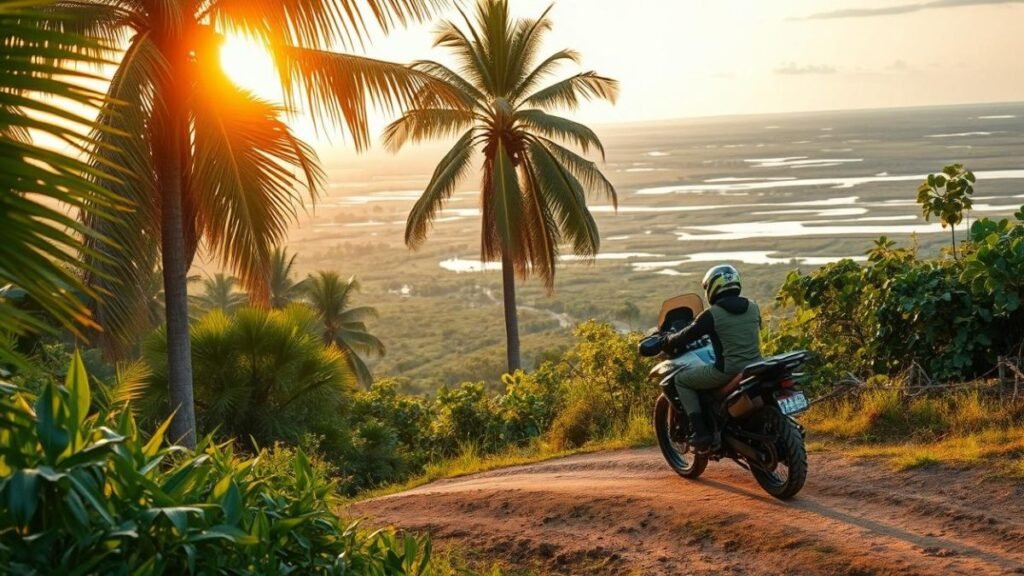
Dry Season vs. Wet Season Considerations
Plan your motorcycle trip between May and October for dry, trail conditions. Floodwaters recede, revealing hard-packed paths perfect for riding. From November to April, knee-deep water prevails—ideal for boat tours but challenging for two-wheeled travel.
Pro Tip: Local guides update water depth charts on a weekly basis. Check these before heading into remote areas.
Essential Gear for Flooded Sections
Waterproof panniers and a raised exhaust are non-negotiable. Pack these things:
- Snorkel kits for air intake during deep crossings.
- Quick-release straps to secure gear in case of a tip.
- Anti-fog goggles—humidity hovers near 80%.
Birdwatching and Jaguar Spotting Tips
Dawn rides increase wildlife sightings. Binoculars like the Nikon Monarch M7 clip onto helmets for easy use. Jaguars roam near riverbanks; keep a 100m distance and avoid night rides in their territories.
“Pantanal jaguars ignore motorcycle unless provoked. Respect their space, and you’ll witness nature’s raw beauty.” —Ana, Campo Grande Wildlife Tours
For capybara herds, a short blast of an airhorn scatters them safely. Remember: protected areas require licensed guides—book ahead to avoid fines.
6. Estrada Real: History and Hairpins in Minas Gerais
Step back in time on Brazil’s legendary Estrada Real, where colonial history meets thrilling rides. This 1,600km network of trails once transported gold to coastal ports, now offering riders a journey through 18th-century charm. Expect cobblestone stretches, mountain passes, and towns frozen in time.
Following the Colonial Gold Route
Built over 300 years ago, this road demands respect for its uneven surfaces and steep grades. Local guides recommend:
- Studying weather patterns—rain transforms quartzite cobbles into slick hazards
- Mapping stops at historic waystations like Tiradentes for fuel and stories
Cobblestone Sections and Vintage Motorcycle Advice
Pre-1980 models shine here but need upgrades. Prioritize:
- Adjustable suspension for varying terrain
- Padded gloves to reduce vibration fatigue
Pro Tip: Ride standing on cobbled segments—it improves control and saves your spine.
Ouro Preto’s Baroque Architecture Break
This UNESCO-listed place bans motorised traffic in its core. Secure motorcycles at Pousada do Mondego’s guarded lot, then explore:
- Aleijadinho’s soapstone carvings at São Francisco Church
- Gold mine tours (helmets provided for shaft descents)
“Estrada Real isn’t just a route—it’s a museum where every turn tells a story.” —Luís, Ouro Preto Heritage Guides
7. BR-319 “Manaus-Porto Velho”: The Ultimate Test
Brazil’s BR-319 highway isn’t just a road—it’s a survival challenge. This 885km stretch cuts through the Amazon’s heart, where isolation and rough terrain push riders to their limits. Only the prepared conquer it.
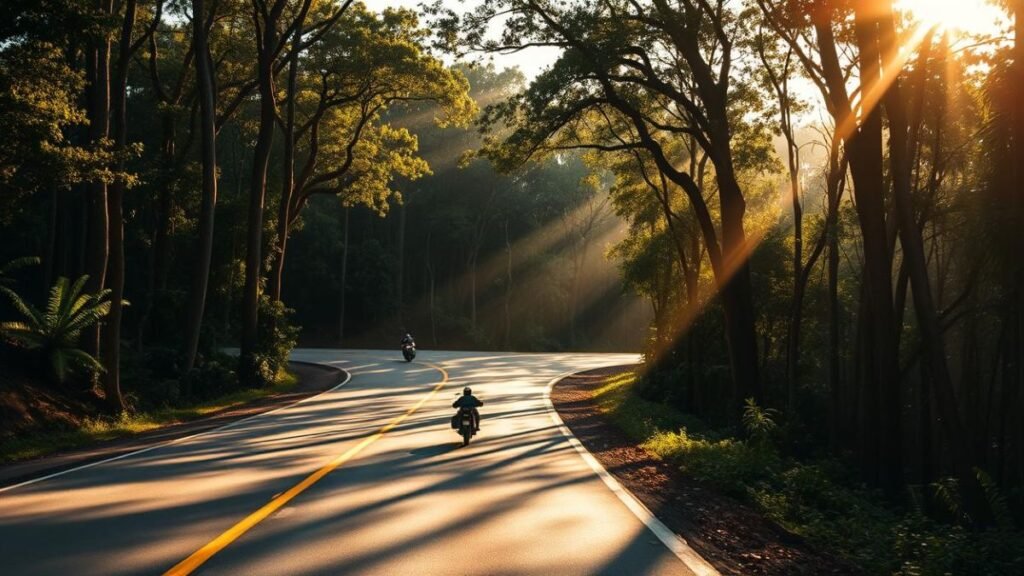
Preparing for 885km of Isolation
Cell service vanishes after the first 50km. Rent a satellite phone in Manaus from Amazon Connect or SatLink Solutions. These providers offer daily rates and emergency SOS plans.
Army checkpoints dot the route. Carry:
- Original ID (photocopies are rejected)
- Vehicle registration
- Proof of malaria prophylaxis (required May–November)
Fuel and Supply Strategies
Gas stations are 300km apart. Use 20L fuel bladders—legal but limited to two per rider. Store them in ventilated bags to avoid fume buildup.
Breakdown recovery averages $800–$1,200. Pack:
- Tire repair kits (quartz rocks shred standard patches)
- Spare air filters (mud clogs them fast)
When to Attempt This Legendary Route
July to October offers the driest conditions. Even then, sudden rains cause flooding in clay sections. Pro Tip: Local riders track weather via WhatsApp groups—join “BR-319 Updates” before leaving.
“This route rewards the patient. Rush, and you’ll miss the howler monkeys and hidden lagoons—or worse, break down.” —Marcos, Porto Velho Rescue Team
Plan your trip at least two weeks in advance. Half the battle is mental—long stretches with no landmarks test endurance. But for the right rider, it’s the adventure of a lifetime.
Planning Your Motorcycle Trip Cross Country in Brazil
Navigating Brazil’s open roads requires more than just packing your gear; it also requires smart preparation. From border paperwork to local customs, these tips ensure a smooth travel experience through every state.
Visa and Motorcycle Import Essentials
Most travellers need a visa for stays over 90 days. Apply through the Brazilian consulate; processing takes approximately 10 business days. For your motorcycle, the Temporary Import Permit (TIP) is mandatory.
Key steps for TIP approval:
- Original vehicle registration
- Proof of ownership (notarised if leased)
- Valid international driver’s license
Pro Tip: Border agents often request additional documents. Carry copies of your passport, insurance, and itinerary.
Portuguese Phrases for Riders
English isn’t widely spoken outside major cities. Master these phrases to find your way:
“Onde posso lavar a corrente?” (Where can I clean my chain?)
“Posto de gasolina mais próximo?” (Nearest gas station?)
For emergencies, learn directional terms like esquerda (left) and direita (right). Locals appreciate attempts to speak Portuguese—it opens doors to hidden stops and friends along the route.
Road Etiquette and Safety Customs
Brazilian highways use a convoy system at toll plazas. Combine into groups of 5-10 vehicles to receive discounted rates. Solo riders often team up with friends or other travellers.
Remember these unwritten rules:
- Flash headlights twice to signal passing vehicles
- Wave to roadside vendors—it’s polite even if you don’t stop
- Tip mechanics R$20-50 for quick fixes
With paperwork sorted and local norms understood, your cross-country motorcycle trip becomes an effortless adventure. Now, the open road awaits.
Gear Up: Essentials for Brazilian Road Conditions
Brazil’s diverse landscapes demand gear that adapts as quickly as the terrain changes. Whether facing jungle downpours or mountain gravel, the right equipment ensures safety and comfort. Here’s how to pack smart for every challenge.
Tire Selection for Mixed Terrain
Choose tires based on your route’s dominant surfaces. For the Trans-Amazonian Highway’s mud or Chapada’s sandstone, consider:
- TKC 80: Aggressive tread for loose terrain but noisy on pavement.
- Mitas E-07: Balanced for 70% paved roads, with durable sidewalls.
*Pro Tip:* Local riders swear by tubeless setups—they handle sharp rocks better and simplify field repairs.
Rain Gear for Tropical Downpours
Brazil’s rain arrives fast and heavy. Pack these things:
- Compact, breathable jackets (e.g., Klim Latitude).
- Waterproof boot covers to avoid soaked socks.
- Anti-fog inserts for your helmet visor.
“A sudden storm can drop visibility to zero. Always check forecasts at army checkpoints.” —Ana, BR-319 Rescue Team
Compact Luggage Solutions
Space-saving strategies for long hauls:
- Compression bags with lockable straps to prevent shifting.
- Hydration packs are modified with anti-leak valves (preventing mould in humid conditions).
- Mosquito netting that clips onto helmet vents for Amazon stops.
Customs note: Knives over 3.5 inches may be confiscated—opt for compact multi-tools.
Easter Eggs
Conclusion: Your Brazilian Motorcycle Adventure Awaits
Your next great adventure isn’t just a ride—it’s a story waiting to unfold. Brazil’s routes stand unmatched, blending rugged terrain with vibrant culture. Whether it’s the Amazon’s solitude or coastal curves, each mile leaves a mark.
Final checks: Verify international insurance covers off-road incidents. The Brazilian Motorcycle Association hosts monthly meetups, ideal for swapping routes and gaining local insights.
Plan by season: April–October for dry trails, November–March for lush greenery. Save consulate contacts in your phone. Cities like Rio and Manaus have 24/7 support.
This journey isn’t just about the roads. It’s about the people, the sunsets, and the stories you’ll tell for years. Ready to write yours?
Learn more about Motorcycle Tour.
FAQ
What’s the best time of year for a cross-country ride in Brazil?
The dry season (May to September) is ideal for most routes, especially in the Amazon and Pantanal. Coastal runs can be enjoyed year-round, but be sure to check regional weather patterns.
Do I need special paperwork to bring my motorcycle into Brazil?
Yes. You’ll need a Carnet de Passage for temporary import, as well as valid registration and insurance. Some routes near borders may require additional permits.
How do I handle fuel stops on remote routes, such as BR-319?
Carry extra fuel cans and plan stops in towns like Humaitá. Local knowledge is key—ask truckers or other riders for updates on station availability.
Are there motorcycle repair shops along these routes?
Major routes have mechanics in larger towns, but remote areas like Chapada Diamantina require self-sufficiency. Learn basic repairs and pack a toolkit.
What gear is essential for Brazil’s varied climates?
Waterproof layers for rainforests, ventilated jackets for coastal heat, and sturdy boots for rough terrain. Mosquito repellent and hydration packs are must-haves.
Is solo riding safe on these Brazilian routes?
Popular routes, such as Serra do Rio do Rastro, are safe to solo, but remote trails are best tackled with a buddy. Always share your itinerary with someone.
Can I rent a motorcycle instead of bringing my own?
Yes, companies in Rio or São Paulo offer adventure motorcycles. Confirm insurance coverage for off-road use and check tire conditions before departure.
How do I navigate Brazil’s complex road systems?
Use offline maps, such as Maps.me, for areas with poor signal. BR highways are well-marked, but secondary roads may lack signage; local advice is helpful.

